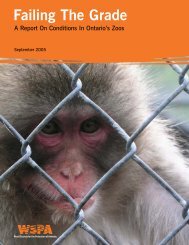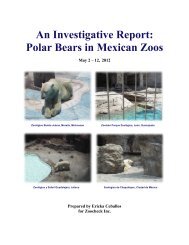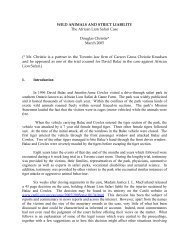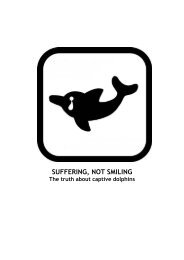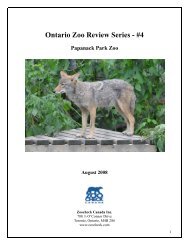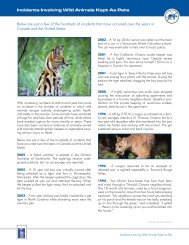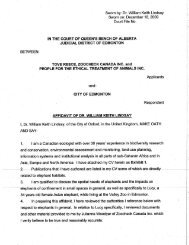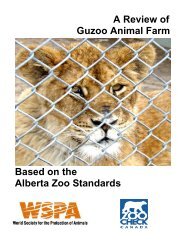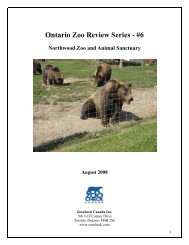STATUS OF BEAR WELFARE
STATUS OF BEAR WELFARE
STATUS OF BEAR WELFARE
You also want an ePaper? Increase the reach of your titles
YUMPU automatically turns print PDFs into web optimized ePapers that Google loves.
Status of Bear Welfare in Cherokee, North Carolina<br />
To avoid direct sunlight, the bears must retreat to the shaded areas cast by each wall.<br />
Subordinate bears are often relegated to the sunny spots. Many of the pits may be heat traps.<br />
Ventilation is poor, so temperatures rise during the day as the sun moves from east to west. The<br />
absence of appropriate substrate materials, furnishings, and shelter makes it impossible for the<br />
bears to engage in normal thermoregulatory behavior. During hot summer days, the bears may<br />
suffer from heat stress because they have no areas where they can obtain relief except for the<br />
small, shallow pools. There was no evidence of additional shade structures, access to off-exhibit<br />
areas, fans for air circulation, misters, or anything else that would mitigate enclosure<br />
temperatures.<br />
Shelters that provide opportunities to retreat from sunlight and inclement weather, including cold,<br />
wind, rain, snow, and storms must be provided to all bears in captivity. Sometimes a bear will<br />
enjoy standing outside in a light rain if it is a warm summer day, but storms last from minutes to<br />
days on cold fall, winter, and spring days. This does not offer the bears any possibility of drying<br />
off in a reasonable amount of time. The bear’s coat is composed of a short undercoat and longer<br />
hairs called guard hairs. The fur works to insulate the body from extreme cold and extreme heat<br />
by creating a layer of temperate air between the skin and the environment. The fur’s insulation<br />
does not function effectively when wet. Bears know this, and in the wild and in captivity (when<br />
given a choice), they will seek shelter from rain. Because bears know better than humans what is<br />
best for their own well being, the enclosure must give bears the option of getting out of the<br />
elements, as they would in the wild.<br />
Bears engage in a variety of thermoregulatory behaviors to heat up or cool down but were<br />
prevented from doing so in these exposed pits. Being too hot or too cold is not only<br />
uncomfortable, it is a physical and psychological stressor.<br />
Chief Saunooke Bear Park<br />
Some of the pits had small overhangs (dens) where a bear could go in inclement weather, but<br />
there was usually only one shelter for at least two bears (photo 3). In such an arrangement, bears<br />
who do not get along with each other (and this occurs with all groupings of bears at some point,<br />
especially in such confined spaces) are forced to make a choice between being in the shelter<br />
area with an incompatible bear or staying outside in poor weather. In cases like this, subordinate<br />
bears often opt to stay outside away from the other bear. Shelters that can accommodate all<br />
animals at the same time must be available.<br />
These overhangs were usually positioned in a corner and open to public view. None of the pits<br />
had privacy areas that would allow the bears to remove themselves from public view or the view<br />
of each other. Where doorways to interior accommodation were observable, they were closed.<br />
Cherokee Bear Zoo<br />
The only protection from sunlight consisted of angled sections of lightweight, transparent shade<br />
cloth that was only a fraction of the size of the pit’s open area and positioned on the back side of<br />
several of the enclosures. These would provide only light screening from the sun in a small<br />
portion of the pit at certain times, while the walls of the enclosures would cast some shadow at<br />
other times (photo 4).<br />
AN INVESTIGATIVE REPORT <strong>OF</strong> CHIEF SAUNOOKE <strong>BEAR</strong> PARK, CHEROKEE <strong>BEAR</strong> ZOO, AND SANTA’S LAND | 21





